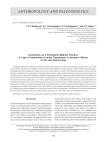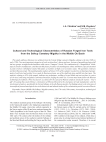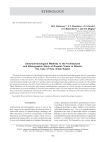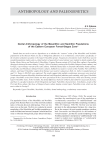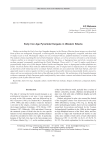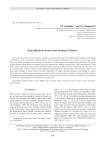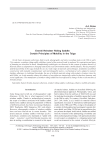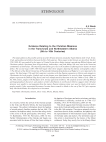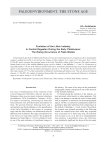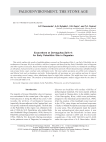Статьи журнала - Archaeology, Ethnology & Anthropology of Eurasia
Все статьи: 351
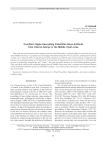
Cruciform signs decorating Paleolithic bone artifacts from Cherno-Ozerye II, the Middle Irtysh area
Статья
Бесплатно
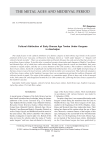
Cultural attribution of Early Bronze Age tombs under kurgans in Azerbaijan
Статья обзорная
Бесплатно
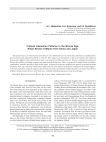
Cultural interaction patterns in the Bronze Age: ritual bronze artifacts from Korea and Japan
Статья
Бесплатно
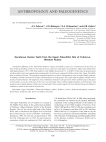
Deciduous human teeth from the Upper Paleolithic site of Yudinovo,Western Russia
Статья обзорная
Бесплатно
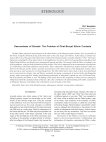
Descendants of eleudei: the problem of oirat-buryat ethnic contacts
Статья
Eleuths (Ölöts) played an important part in the ethnic history of the Mongol peoples of Inner Asia, in particular of the Oirats, being the dominant group of the Oirat union at the early stages of its history. In this study, an attempt was made to fi ll in one of the gaps in the ethnic history of the Turko-Mongol peoples, using the ethnonym “Ölöt”. The major limitation in studying the Oirat ethnic history is the insuffi ciency of sources. Much can be gained from using Buryat and Sakha (Yakut) folklore, specifi cally epics, genealogical legends, and tales. The reason is that the Ölöts, according to one of the hypotheses, took part in the formation of those peoples. This idea is supported by the reconstruction of protoforms of certain Buryat and Yakut ethnonyms and eponyms. Their comparative and historical analysis indicates ethnic ties between the Buryats and the Yakuts, and their participation in the ethnic history of the Mongolian stratum. These facts open up a wider perspective on Turko-Mongol ties. The Ölöt ethnic history shows them to have been distributed across vast territories of Inner Asia and Siberia, eventually becoming a component of various Turkic and Mongolian groups, while preserving their identity and featuring prominently in ethnogonic legends not only of Dörben-Oirats, but of the Buryats and Yakuts as well. The fi ndings of this study attest to the complexity of ethnic processes among the Mongolian and Turkic speaking nomads of Eurasia. Also, they contribute to the understanding of the ethnic composition of Mongolia, Buryatia, and Yakutia, thus widening the scope of studies on the Altai.
Бесплатно
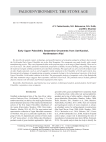
Early Upper Paleolithic serpentine ornaments from Ust-Karakol, Northwestern Altai
Статья обзорная
Бесплатно
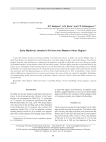
Early medieval jeweler's kit from the Western Amur region
Статья научная
A late 9th century jeweler's kit from dwelling 2 at Osinovoye Ozero, a Mohe site on the Middle Amur, is described. Bronze was smelted in a crucible placed on a ceramic support inside a vessel-like furnace. Nine bronze plaques from the same dwelling are compared with negatives of molds in which they were cast. Based on results of the elemental analysis of plaques, these fall into three groups. The fi rst differs from the other two by the source of ore, and plaques of the second group were recast more than once. Most Turkic type plaques were evidently destined for recasting into Mohe ornaments. The latter include one openwork and two fi gured plaques as well as bronze bells found in 2012 in dwelling 3. Because bronze items differing in composition were recast several times, the source of ore cannot be identifi ed. Techniques of manufacturing molds and facing of plaques, used by Central Asian and Mohe artisans, are reconstructed.
Бесплатно
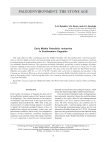
Early middle paleolithic industries in southeastern dagestan
Статья
This study addresses lithic assemblages from the Middle Paleolithic sites Darvagchay-Zaliv-1 and Darvagchay- Zaliv-4, which are highly relevant to the understanding of this stage in Dagestan. We examine paleoclimatic conditions prevailing during the sedimentation at these sites. A detailed description of lithics is provided. Artifacts were discovered in a minimally disturbed paleosol. They represent the Middle Paleolithic, specifi cally Levallois technique of primary reduction. Judging by the presence of unlined fi re-pits and the fact that fi nds are scattered over a large area, we infer that these sites evidence multiple short-term occupation. The dates of the sites fall within the Riss-Würm (Eemian, Mikulino) interstadial (MIS 5e)—ca 125–110 ka BP. Parallels with coeval sites in Dagestan and elsewhere in the Caucasus are discussed. Whereas no direct parallels with any Caucasian Middle Paleolithic industries can be found, those of Darvagchay-Zaliv-1 and Darvagchay-Zaliv-4 are consistent with the general evolutionary trajectory of the Caucasian Paleolithic.
Бесплатно

